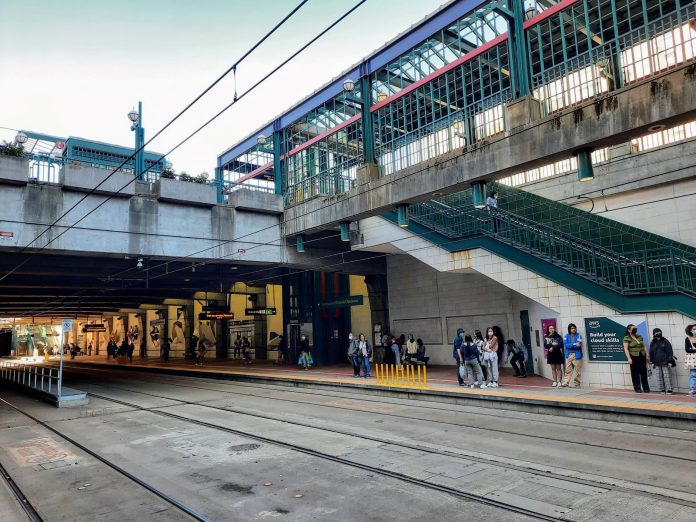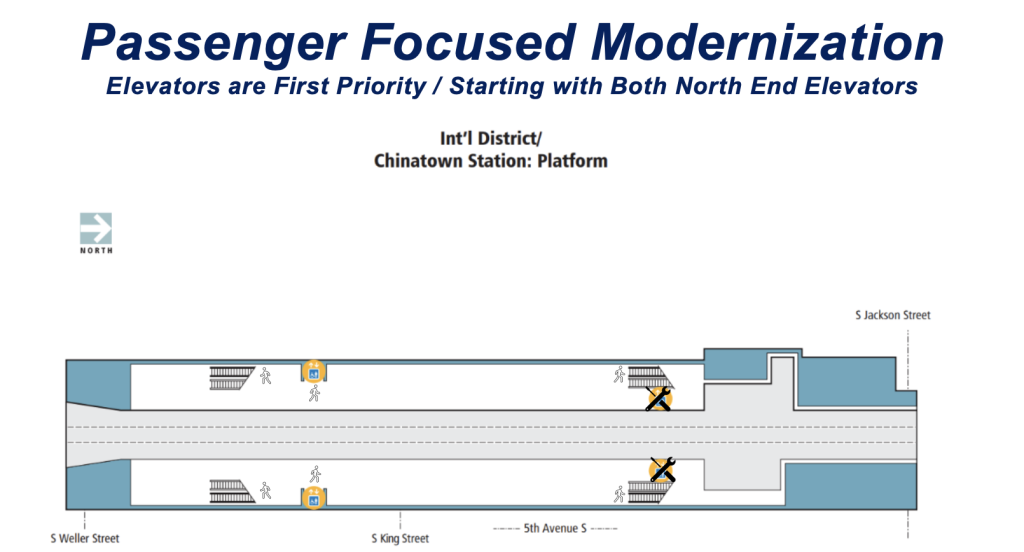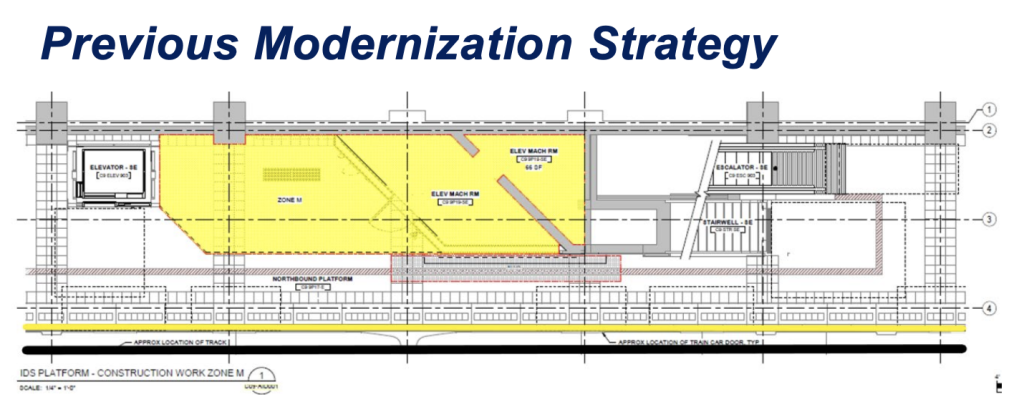
Elevators and escalators at the Chinatown station will all be new by 2026 following phased replacements.
Sound Transit officials have approved the first phase of escalator and elevator modernization in the Downtown Seattle Transit Tunnel (DSTT). That will initially benefit International District/Chinatown station as phases of work are completed through early 2026. Getting to this point, however, has been years in the making.
To many riders, it will be come as no surprise that existing escalators and elevators in the DSTT are functionally obsolete and have been unreliable, leading to routine outages — things have improved in the past year though. Equipment is more than 35 years old — well beyond its useful life — and should have been replaced a decade or so ago, according to industry standards.
At the time, King County Metro still owned and managed the DSTT, and even carried out joint bus and rail operations in the tunnel until March 2019. The agency should have been responsible for replacing the equipment, but neglected to do so. Instead, Metro left the vertical conveyances in terrible condition and complicated passing of the baton to Sound Transit.
As a consequence, Sound Transit has been investing a considerable amount of resources to keep escalators and elevators in operation and to modestly upgrade them until full replacement can be achieved, a process poised to span a decade.
In the first phase of DSTT vertical conveyance modernization, Sound Transit will replace four escalators and four elevators at International District/Chinatown station in what will essentially be like-for-like fashion. That means replacement will happen in the footprint of existing vertical conveyances. No additional units will be installed as part of the project. Cost for the project is about $16 million and Schindler, a leading vertical conveyance manufacturer and the agency’s primary maintenance contractor, will carry out the replacement work over a two-year period.
The new equipment should appear similar in style to vertical conveyances at the new U District, Roosevelt, and Northgate stations, and be much more robust than older models, according to agency staff.
Escalators will have extra protection from debris and the elements for electrical components and enhanced motor units, improving reliability and performance. Escalators will also have a “sleep mode” for when not in use by riders, slowing the speed to save energy use (about 30% in power savings) and extending the life of units. Elevators will have better door hardware, flooring, and lift systems. All equipment will have live monitoring devices to alert staff of any service outages.
While the new escalators will be reversible, all four escalators will continue to provide up service only from platforms. This is in keeping with agency policy that escalators only run in the up direction if there aren’t additional escalators paired in an escalator bank fashion. Riders wishing to go downward will have to use stairs or seek out elevators.

Sound Transit plans to use an intentional, passenger-focused sequencing process to replace the escalators and elevators at International District/Chinatown station. The agency’s contractor will start with replacement of elevators and then transition to escalators. Replacement will be rolled out in four phases between early 2024 and early 2026: first the north end elevators, second the south end elevators, third the north end escalators, and fourth the south end escalators. The goal is to accomplish replacement of equipment for riders that need the most accessibility first and to always — as much as possible — have vertical conveyance equipment available between each platform and street level.
Planning for replacement of the station’s vertical conveyances began in 2021. In developing a replacement plan, Sound Transit staff looked to current agency escalator specifications used in new facilities for requirements. The agency’s head of vertical conveyances, John Carini, told an agency committee last month that trying to fit those in the existing tunnel environment was a problem.
“Expansion specifications called for large programmable logic controllers for escalators, which would require the modernization effort to either build new machine rooms within stations or expand existing areas to accommodate the much larger controllers that would no longer fit within the existing footprint of the escalator,” Carini said. That would have a permanent knock-on impact to riders with less platform space as well as harsher temporary construction impacts.

Instead, Carini said, that the agency pursued a strategy to try to meet the specifications as closely as possible but work within the existing footprint of escalators. Work on modernization strategies evolved last year as the agency engaged with consultants and manufacturers on less impactful solutions.
“What we found was that the manufacturers were indeed capable of producing smaller controller cabinets that were able to be located within the existing escalator pit areas, eliminating the need for additional or expanded machine rooms while still being able to install upgraded equipment with more robust components,” Carini said. The upshot of this, too, is that Sound Transit will be able to shorten construction timelines and limit potential single-tracking operations and construction areas that would otherwise impact riders.

The agency’s wider DSTT vertical conveyance modernization effort will replace an additional 50 pieces of equipment at Pioneer Square, University Street (Symphony), and Westlake stations through 2033, moving from south to north. The total program cost, including International District/Chinatown station, is expected to reach $119 million. Next year, Carini expects the agency to brief the Sound Transit Board of Directors on the next set of replacement plans and seek approval for construction.
Sound Transit, however, will continue to replace aging vertical conveyances outside the DSTT, as part of a 20-year plan. “We continue to monitor the performance of our elevators and escalators outside of the tunnel as some of these assets will begin reaching the end of life while we are continuing work within the tunnel,” Carini said. “By our current projections, we estimate to have a total of 179 assets modernized by 2044 while our portfolio with elevators and escalators is estimated to grow to 575.”
Total replacement costs of the 179 vertical conveyances are estimated to reach $490 million. Of course, replacement of vertical conveyances will be an ongoing program in perpetuity, so it’s essentially a standard state of good repair capital program cost going forward.
Stephen is a professional urban planner in Puget Sound with a passion for sustainable, livable, and diverse cities. He is especially interested in how policies, regulations, and programs can promote positive outcomes for communities. With stints in great cities like Bellingham and Cork, Stephen currently lives in Seattle. He primarily covers land use and transportation issues and has been with The Urbanist since 2014.

